Wednesday
Dharma TeachingsSeven-Line Supplication to Padmakara
Our series on the Shambhala chants continues, with the traditional supplication to Padmasambhava
by Russell Rodgers
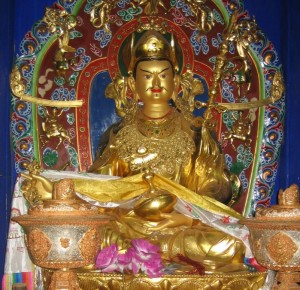 HUM
HUM
In the northwest of the land of Uddiyana,
On a blooming lotus flower,
You have attained supreme, wondrous siddhi. You are renowned as Padmakara, Surrounded by your retinue of many dakinis. We practice following your example.
Please approach and grant your blessing. GURU-PADMA-SIDDHI HUM
HUM is the seed syllable of mind–not the discursive mind that we are so familiar with, but the completely awake mind of emptiness and limitless possibility. This is the mind of Padmasambhava, who is also known by the name Padmakara.
The Seven-Line Supplication is a famous prayer to Padmasambhava, a powerful yogi renowned in Tibet as the “Second Buddha”. Padmasambhava’s exact dates are unclear, but it seems that he lived in the 8th or 9th centuries CE. His birth had been prophesied over a thousand years earlier by Buddha Sakyamuni. Padmasambhava was born in Uddiyana, which at the time was a prosperous kingdom in a fertile river valley near the border of what is now Pakistan and Afghanistan. At that time, this valley was a thriving Buddhist society on the trade route between India and Persia. Now, it is in the chaotic tribal lands of Pakistan.
On a blooming lotus flower,
You have attained supreme, wondrous siddhi.
These lines have a literal meaning and some symbolic meanings as well. Literally, the legend of Padmasambhava’s birth says that he was not born of a mother and a father, but instead spontaneously appeared on a giant lotus flower in the middle of a lake. Therefore the names Padmasambhava or Padmakara contain the word “padma,” which means “lotus flower.”
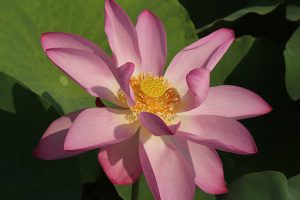 The symbolic meaning of these lines derives from the fact that lotus flowers grow out of the mud on a lake bottom, but are themselves immaculate and unstained. According to the legend, Padmasambhava was one of those rare individuals who arrive in this world unstained by previous karma, in full realization of the nature of their total being. In other words, they are fully enlightened. Such persons may appear to need to tread on a path, but that is only to demonstrate for others that a path exists, and perhaps, to learn some skillful means to ripen others.
The symbolic meaning of these lines derives from the fact that lotus flowers grow out of the mud on a lake bottom, but are themselves immaculate and unstained. According to the legend, Padmasambhava was one of those rare individuals who arrive in this world unstained by previous karma, in full realization of the nature of their total being. In other words, they are fully enlightened. Such persons may appear to need to tread on a path, but that is only to demonstrate for others that a path exists, and perhaps, to learn some skillful means to ripen others.
Another level of symbolism evoked by this image has to do with the path of Dzogchen, the Great Perfection—the highest of all the Buddhist practice vehicles. At this level, one is presented with the view of a fully enlightened person, and asked to step directly into that view. In contrast, the lower level teachings speak to our more predominate and immediate concerns as a way starting us along the path. These concerns might include anxiety about our living situations, fear of impermanence, the need for compassion in our lives, or simply the desire for a little clarity and mental peace.
 From the Great Perfection point of view, our own enlightened, fully awake mind is already within us. It is not only awake, but it manifests as everything that we experience. Even though it is in us and all around us, we do not recognize it. This mind is one of limitless possibilities. One of these possibilities is that it can obscure itself by manifesting ignorance and solidified thoughts and concepts. Like Padmasambhava, this mind isn’t born from external causes—it doesn’t have a father or mother. Meditative practice doesn’t produce this mind. It only uncovers it. Even as we meditate, that enlightened mind is what manifests as the self that meditates, the objects of meditation and the obscuring thoughts. It manifests the seeming mud of samsara, but is itself immaculate.
From the Great Perfection point of view, our own enlightened, fully awake mind is already within us. It is not only awake, but it manifests as everything that we experience. Even though it is in us and all around us, we do not recognize it. This mind is one of limitless possibilities. One of these possibilities is that it can obscure itself by manifesting ignorance and solidified thoughts and concepts. Like Padmasambhava, this mind isn’t born from external causes—it doesn’t have a father or mother. Meditative practice doesn’t produce this mind. It only uncovers it. Even as we meditate, that enlightened mind is what manifests as the self that meditates, the objects of meditation and the obscuring thoughts. It manifests the seeming mud of samsara, but is itself immaculate.
This style of introducing very profound teachings at the beginning of the journey should be somewhat familiar to those who have done Shambhala Training. In Level I, we are introduced to the notion of “basic” goodness. Basic goodness means that, within a state of perfect nowness, before ordinary thoughts of good or bad have arisen, everything that arises is pure and unstained. Everything is primordially and basically “good.” It is “good” beyond and before ordinary thoughts of good or bad.
With respect to the Great Perfection teachings, it is said that people like Padmasambhava, who have practiced a great deal in previous lives, will recognize, internalize and accomplish the teachings as soon as they hear them. Ordinary people like ourselves may feel that these ideas have the ring of truth, but we need to practice on a more ordinary level in order to extend beyond the words into actual, continuous manifestation. For us, the more ordinary paths of renunciation, generation of compassion, and shamatha and vipashyana are more appropriate. Even so, we might be able to appreciate that the legend of Padmasambhava’s birth could also be an allegory for discovering our own pre-existing enlightened nature, a nature that, like Padmasambhava, doesn’t have to be produced by external causes such as a father or mother.
…… You have attained supreme, wondrous siddhi…
“Siddhi” means “power”. There are two kinds: relative and absolute. Relative siddhis are powers that relate to the phenomenal world. They could refer to powers as simple as the mechanical aptitude to fix cars, or to highly unusual abilities such as being able to leave foot prints in stone, read minds, or the ability to predict the future. Absolute siddhi is the ability to recognize and remain in the totally awake wisdom mind. Relative siddhis often arise as by-products of enlightenment, but sometimes they appear spontaneously in otherwise ordinary individuals. In the case of ordinary people, the more supra-mundane relative siddhis are regarded as potentially problematic because they can result in seductive side-tracks that actually enhance the sense of solidified self.
Padmasambhava’s legendary siddhis came into play with respect to the obstacles that arose in bringing the dharma to Tibet. Others before him had failed. Padmasambhava, in fact, was working on a grand scale–a scale in space involving a whole country and in time involving many centuries. Because of his ability to see into the future, he could tell when, at a later time, particular teachings would be appropriate, He left many teachings that would be re-discovered at the appropriate time by special yogis called tertons. The Seven Line Supplication to Padmakara, for example, was discovered by a yogi named Chokyi Wangchuk. Our own founder, Trungpa Rinpoche, also discovered many such teachings when he was a young man in Tibet.
On his arrival to Tibet, Padmasambhava faced resistance from the native religious traditions, from the rugged physical environment, and from what might be called the psyche of the land and people. Many of these obstacles are described in the stories as demonic forces. If Padmasambhava were trying to bring dharma on a such a vast scale to North America today, one could imagine the obstacles that would be presented by the national psyche of North American materialism and the existing theistic religions. These were the obstacles that Trungpa Rinpoche faced, and one can see why the story and example of Padmasambhava were so important to him.
Because of Padmasambhava’s profound openness, he saw the energies involved in those obstacles as opportunities. Padmasambhava harnessed those energies as aides. Many of the protector practices that are done in Tibet today originated from Padmasambhava’s encounters with those forces.
…..Surrounded by your retinue of many dakinis…
Dakinis are embodiments of the feminine principle—either in human or non-human form. The feminine principle in tantric Buddhism refers to the insight, or prajna, that discovers the emptiness of our conceptual, thought-based solidifications of the world. The masculine principle is more connected with methods or skillful means. Padmasambhava used many masculine skillful means to subdue the obstacles facing him. However, he knew that unless the masculine principle of skillful means is balanced with the feminine principle of openness, emptiness and insight, the skillful means would become twisted into mere spiritual and materialistic technologies, such as those often used to maintain modern nation states and corporations.
Being surrounded by many dakinis has different levels of meaning. On one level it could be said that Padmasambhava was surrounded by the feminine principle in the form of female goddesses, and thus was able to balance masculine skillful means with the feminine principle of insight. On another level, Padmasambhava took many female human consorts and brought them into enlightenment. Among these was Tibet’s most famous woman yogi, Yeshe Tsogyal. Western observers might think that this is just another example of patriarchal harem building. However, Yeshe Tsogyal herself took male consorts and taught them in the same way. This sort of relationship between teacher and student would be the essence of politically incorrectness today, but in the Tibetan culture, if a teacher is truly egoless, and the student is ready, the intimacy and power of the male/female relationship presents unique opportunities for transmission of the true heart of the teachings.
…. We practice following your example, please approach and grant your blessings…
Again, there are at least two levels of understanding possible. Tibetan legend has it that Padmasambhava never actually died. He resides in the Copper Colored Mountain pure land, beyond the view of ordinary humans. From this vantage point, he watches over the dharma, and issues forth when called.
Another, second level of understanding suggests that the more we know of his story, the more merely thinking of Padmasambhava will open our minds to vast possibilities. Part of this level of understanding is that our own Padmasambhava nature is always there, waiting.
 Russell Rodgers has been wondering about this kind of topic for the 39 years that he has been practicing. He resides in the Kootenay mountains of British Columbia, in the town of Nelson, and has graciously agreed to allow publication of his beautiful essays on the Shambhala chants here in the Times.
Russell Rodgers has been wondering about this kind of topic for the 39 years that he has been practicing. He resides in the Kootenay mountains of British Columbia, in the town of Nelson, and has graciously agreed to allow publication of his beautiful essays on the Shambhala chants here in the Times.

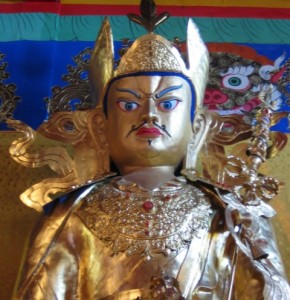
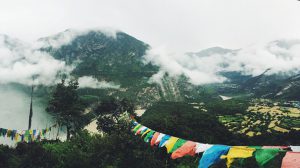
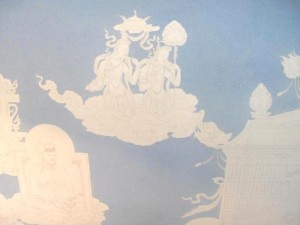




Oct 24, 2016
Reply
Incredibly helpful commentaries on the chants.
Oct 20, 2016
Reply
Thank you so much for your commentaries on various chants! I absolutely love them. The are so rich with history and wisdom. They have allowed me to deepen my view and enjoyment of the chants. I appreciate your generosity!
Oct 20, 2016
Reply
Thanks for this Russell! Such a potent little chant. Anyone who wants to go deep with this should read Mipham the Great’s “White Lotus.” It unpacks the 7-Line Supplication from five different perspectives, even unpacking the final mantra syllables in five different ways. An astounding text. Fun fact: Mipham the Great wrote it very quickly in the 1800s and then lost it for 30 years. After decades, his assistant did a multi-week search of his household looking for it and finally found it. Otherwise, this text might have been lost forever.